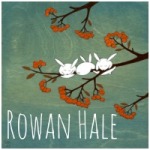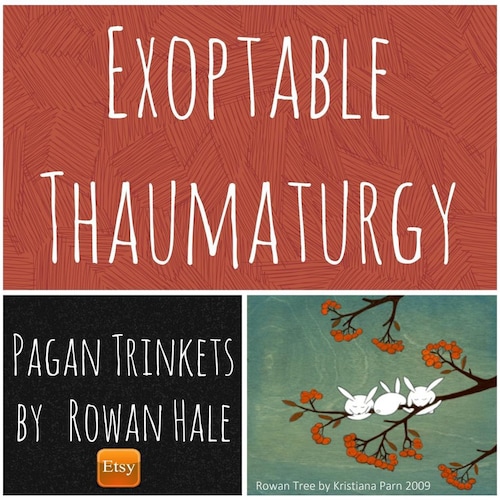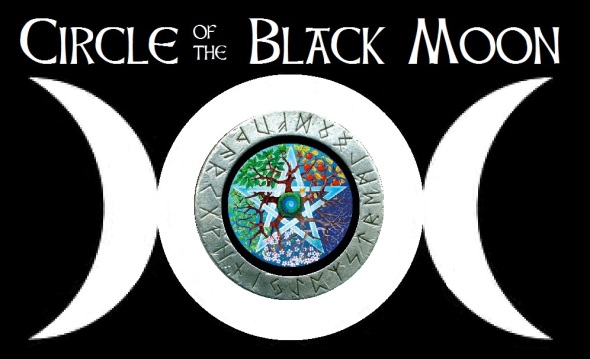Full Moon in Aquarius & Rune Crafting

 I was browsing Pinterest and found a post featuring a Rune Chain crafted for home protection & goals. I thought it was a really innovative way to use runes as decor, especially the combining of runes into multi-meaning symbols (kind of like sigils). I am very interested in how people create tools and objects that ‘hold’ their intent, and this seemed like such a wonderful idea that I had to see if I could make it work for me. I am so pleased with how well it turned out!
I was browsing Pinterest and found a post featuring a Rune Chain crafted for home protection & goals. I thought it was a really innovative way to use runes as decor, especially the combining of runes into multi-meaning symbols (kind of like sigils). I am very interested in how people create tools and objects that ‘hold’ their intent, and this seemed like such a wonderful idea that I had to see if I could make it work for me. I am so pleased with how well it turned out!
In the original post, the author was very thorough in laying out all of her steps, so I won’t cover that again. The part that interested me most was the actual crafting of the runes and how they were combined, so that’s what I am going to focus on in my post.
Here’s a disclaimer that I feel like I should probably make: I am in no way a rune-work expert. Other than a couple of classes I’ve attended on runes, and a couple of craft days where I made sets of runes, that’s about the extent of my knowledge. They’re not a thing that I use terribly often, though I have gone through phases in the past where I’ve been more interested in using and working with them.
That said, I really like them: the having of them and holding and handling of them. I like the way they’re shaped and formed, and find them incredibly visually appealing. I like them for their simplicity and their complexity. On the surface, runes are a fairly straightforward type of tool. They can be used to create words and text, or cast for their divinatory meaning, or used on a daily basis as a meditation focus or ‘wisdom/warning of the day’ type of practice. On a deeper level, runes carry ancient memory and meaning. Using them ties the practitioner to an ancient history, and sometimes that connection is felt more than others. I like divinatory tools with more than one meaning, and runes fit that profile. To some degree, the interpretation of the runes – be it a single drawn rune for the day or a casting – is left up to the practitioner to interpret. Those interpretations vary according to so many factors, and it is that kind of personalization of practice that appeals to me so very much. That’s why this project spoke to me with such a loud voice!
I spent some time looking up the meanings of various runes, and deciding on words, meanings and aspects of their meaning that I liked. As I wrote and doodled, I found runes that worked well together or complimented each other and worked out how I wanted to combine them. Once I had a few that represented the main ideas I wanted to bring to life in the chain, I drew them in the order I planned to arrange them in on a piece of paper. Then I created a word cluster for each of my created symbols, which helped me decide what aspects I wanted to draw on, and how the runes worked together to create a specific or more focused meaning.
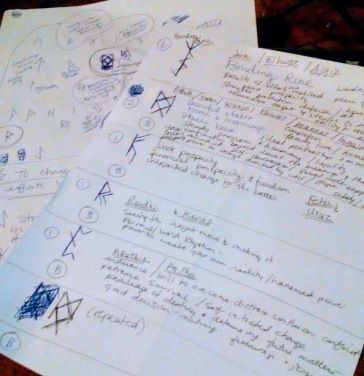
To start with, I created a rune symbol that combines ‘Algiz’, ‘Eihwaz’, and ‘Jera’. I really like her concept of ‘binding runes’, but I tweaked her meaning a bit; rather than a rune that reinforced the symbol above it, I chose to create a binding rune that reinforces the entire chain, and is repeated throughout it as a central feature. My binding rune pulls on the parts of the runes used throughout the chain to ensure that the goals expressed in the chain are reasonable, and that the efforts we put into realizing them are matched with the strength to see them through. There’s a protective/defensive element as well; to protect our home and family, both physically and spiritually.
I made my chain with 6 binding runes. I began the chain with it, and ended it with a binding rune, to reinforce the intent and purpose of the chain. The binding rune is also between each rune and the next, to reinforce the strength of will and restate the intent.
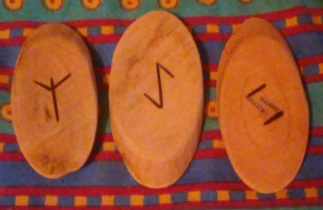
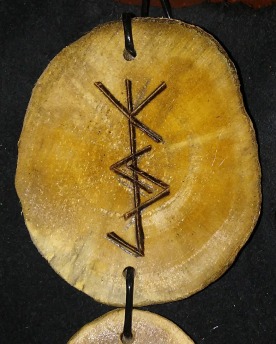
The second rune (and the next to the last rune) is the most complex. I am calling this the ‘marriage rune’. It’s another type of binding rune, and holds space both in the beginning and end of the chain. My husband and I celebrated 18 years of marriage (and over 20 of coupledom) the first week of August, and our marriage is the platform from which every other aspect of our home and family are built upon. It is the stable base that serves as the foundation for every aspect our lives. It is the thing without which our family would not exist, and is therefore absolutely central to anything else that will happen in our home. From that perspective, this is perhaps the most important rune form in my chain.
The runes I chose to create this symbol are ‘Ehwaz’, ‘Mannuz’, ‘Dagaz’, ‘Gebo’, ‘Wunjo’, ‘Ingwaz’, and ‘Othala’. Combined in this way, the symbol draws on the individual aspects of each of the runes used to create it to reflect the importance of, strengthen and protect our bond and union as the touchstone of our family, as well as calling on the elements of the individual runes that speak to home life, communication, harmony and joy.
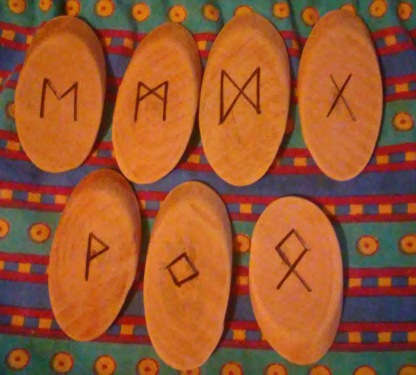
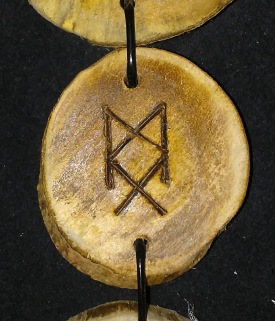
After the binding runes and marriage rune, there are three focused runes, intended to reinforce the values we favor in our home, and what we want for our children, separated (and reinforced) by the binding rune between each of the three focused runes.
The first, I call the ‘prosperity’ rune. It is made up of ‘Fehu’ and ‘Uruz’. There’s an element of good fortune and luck tied to this one, but also the wisdom and vision to make sound investments and financial decisions. There’s a fair amount of self-direction as well, and since independence and leadership are two things I value for my children, I think that makes for a good combination to represent prosperity in both a financial sense and generally-in-life sense.
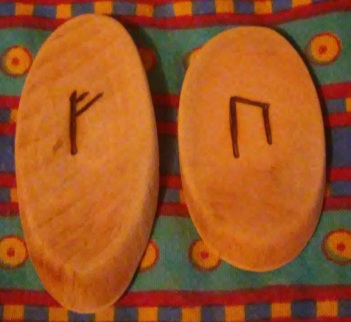
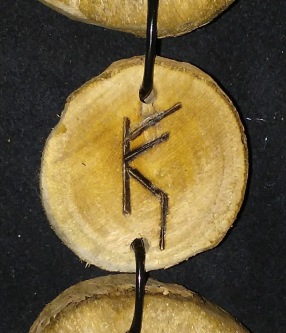
The second rune, I’m jokingly calling the ‘upward mobility’ symbol, and is made up of ‘Raido’ and ‘Kenaz’. In reality, it would probably better be described as the ‘self-actualization’ rune. Raido is traditionally the ‘travel’ and ‘protection in travel’ rune, which works for my kids’ futures as they’re getting to the age where plans for college and embarking on their own journeys outside of our little nuclear family are imminent. More than that, though, I am calling on the ability to see the right move and make it, and the power that is inborn within them (and in all of us) to shape our own futures into happy and successful ones. I very much want both of my children to find their calling – to find the thing or things that make their souls happy. I want them to find their unique rhythm, and their place within the rhythm of the world, and thrive there.
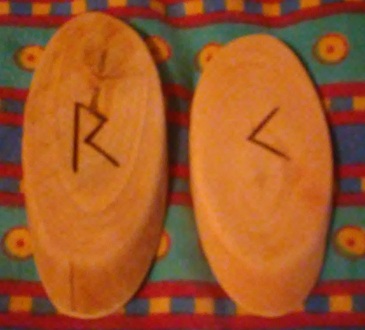
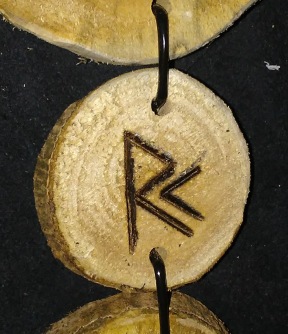
The third symbol is my ‘strength and endurance’ rune. It’s made up of ‘Pertho’ and ‘Nauthiz’. Pertho calls again on being able to determine your future path, and Nauthiz for self-reliance, strength and endurance. Though I am not ashamed to call on good fortune and blessings, I know that a happy life isn’t just handed to you; it takes work – and often a lot of it. Along your path, there are adversities that help shape you into the person you will become, and help you see yourself more clearly; to become who you are ultimately meant to be. Mental illness runs in my family, and it is with a realistic eye that I recognize that my children may also struggle with mental health issues, however much I hope that they escape them. Strength sometimes means accepting weakness and asking for help; endurance means recognizing when you need to stop or slow down so that you can rest and regroup before continuing on. It is those qualities that I call on in this symbol, for my children and for myself.
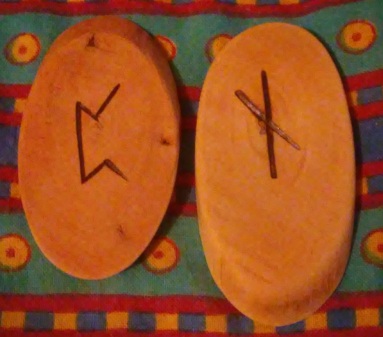
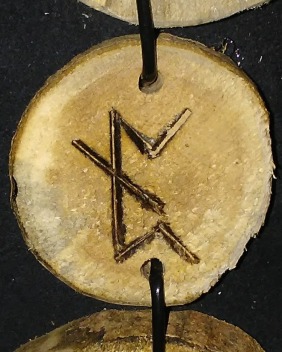
Finishing the chain are the marriage rune again, and the last binding rune, to seal the chain and reiterate the intent and purpose of it.
Last week (last night when I started this post) was the Full Moon in Aquarius. I took my oracle cards out, my moon journal, and my rune chain to cleanse and charge it under the light of the full moon, with palo santo and sage to smudge. It was such a pretty night; fresh from rain all day, but a clear sky towards the evening. Afterwards, I hung the chain on the back of our front door, so it’s visible every day as we come and go.
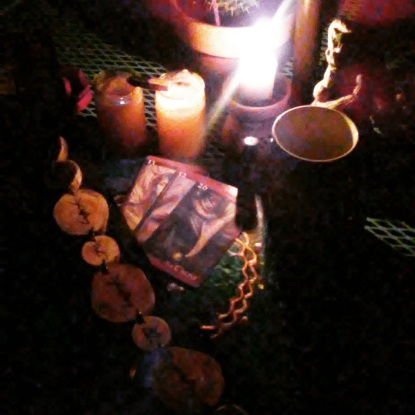
Brightest Blessings,
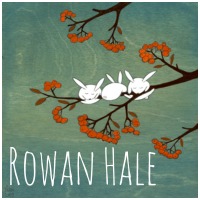
Beyond Pagan 101
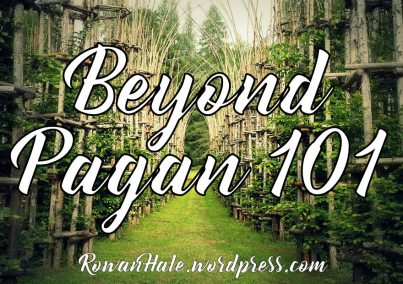 Something I’ve noticed is that when you start browsing Pagan books, the great majority of them are ‘Pagan 101’ – what is is/means to be Pagan, how Pagans practice their faith, etc. I am a researcher by nature, and tend to be drawn to books on spirituality and on Pagan paths in particular. It’s been disappointing to see the same material rehashed over and over and over again: what Sabbats are, correspondences, dedication rituals and how to ‘be’ pagan – the very basics. Oh sure, it’s a little different; re-branded or spiffed up and published under a new name or path, but so much of it is the same basic, beginner material that you can find all over the place.
Something I’ve noticed is that when you start browsing Pagan books, the great majority of them are ‘Pagan 101’ – what is is/means to be Pagan, how Pagans practice their faith, etc. I am a researcher by nature, and tend to be drawn to books on spirituality and on Pagan paths in particular. It’s been disappointing to see the same material rehashed over and over and over again: what Sabbats are, correspondences, dedication rituals and how to ‘be’ pagan – the very basics. Oh sure, it’s a little different; re-branded or spiffed up and published under a new name or path, but so much of it is the same basic, beginner material that you can find all over the place.
I’ve been thinking about why that is; why so many books are ‘beginner’ style books for Pagan spirituality, and have come to several observations. First, I think that a lot of Pagan practice is ‘first generation’. People are dissatisfied with mainstream spirituality and they go exploring. Because there are so many different styles of Paganism, it’s hard to ‘pick one’, and so each style or path has its own interpretation of the Path. Additionally, there are different ‘branches’ of Paganism: Wiccan, Heathen, Asatru, Druidic, Dianic… the list goes on, each with their own specific way of doing things.
Secondly, as information and technology have increased access to information, the sheer volume of beginner Pagans has increased to the point that such a volume of beginner material is necessary. Since there are so many first generation Pagans, there isn’t a large population of people who have practiced long enough to move beyond basics. Although I know many who have been in practice for decades, a great many of those have switched paths or gone eclectic or solitary for lengths of time, and developed their own traditions, rituals and styles of practice and don’t feel the need to publish it publicly. Add to that the general consensus that Pagans don’t like to be told ‘what to do’ or ‘how to worship’, finding an open group to practice with can be extremely challenging, which leaves many/most new Pagans solitary.
Thirdly, of those who have practiced for extensive periods of time, they don’t feel the need to indoctrinate their children into their faith, allowing the children to find their own paths, as it were. Without that indoctrination, children who grow up Pagan may or may not feel the need to pursue their own spiritual path. I know several adults who were raised by Pagan parents and although they may be interested on the fringe, most tend not to practice actively, at least among the people I know in this situation. Obviously, that’s not true across the board, so no slight intended if you’re a third or fourth generation practicing Pagan. These are just my observations, and I’d be interested in hearing yours.
Though I understand these as logical explanations, and accept whatever other possible explanations there may be, they don’t mitigate the fact that the majority of Pagan-centered books available are beginner-level books. For those who have been practicing long enough to have personalized their faith and practice, investing in new books can be disappointing because even seemingly promising books end up containing only a little bit of new information. While I certainly do not claim any authority, I thought I would share some of the ways that I have found helped me to move beyond ‘Pagan 101’ and into a more deeply personal and meaningful practice.
One method I found to circumvent getting trapped in the newbie books has been to move outside of strictly Pagan-themed books and into history, philosophy and world religion books. (Side note: My path isn’t deity-centered, so if yours is, the same types of methods for researching and deepening your knowledge about your pantheon or deities applies.) Beyond a certain point, even the most devout reconstructionist Pagan practitioner is just making stuff up to fill in the gaps in whatever factual/historical recorded information they have managed to piece together. From that viewpoint, their opinion on how you should practice is no more authoritative than yours. Additionally, many strictly Pagan-themed books tend to be European in origin, which means that they may be making recommendations for alignments and correspondences for a different hemisphere, climate or botanical availability than where you;re practicing your path. I am a firm believer is adapting my practice to suit my environment and many nature or earth-based paths focus on that connectivity almost exclusively. It seems silly to try to find herbs or wood to work with that you wouldn’t have any personal connection with because you’ve never seen, touched or smelled it!
If your path is earth-based; hedge-witches, kitchen-witches, and the like, and herb-crafting is a big part of your practice, then you’ll only find a handful of information in your typical Pagan-themed herbal companions. Look into books on gardening – learn native flora and what grows best when. Growing your own herbs, flowers and plants can make them so much more effective when you need them to work and the connection that you have to your garden and materials is a big part of making your path come alive. Continue your education; learn about using plants as medicine, how to distill essential oils, and anything else that strikes your fancy from sources that aren’t strictly Pagan-oriented. If the only information you;re lacking is the magical correspondence, those are easy to find online. If food is your bag, then the same applies; research cooking and recipes; experiment with flavors and use herbs and ingredients that you grow yourself.
I’d also suggest researching folk magic – hoo-doo and root-work, Santeria, Native American religions and other types of old, earthy magic. Many of those types of religions can be hard to find information on, but it’s worth it when you do. If your ancestors come from those religions, then even more so. My personal task over the last year or so is considering how ancient holidays could be modernized. I have posts about Lupercalia and Matronalia, and will be doing similar posts this year. I may not get them ‘right’, but it’s been a fun experiment, and adds value to my practice.
Another way to find more meaning in your practice is just that – practice. If you are a new practitioner, especially if you’re coming out of a religion where Pagan things are taboo, then you may be reluctant to actually do the things that you’re reading about. Even if you’ve ‘been Pagan’ for a long time, but don’t practice, moving beyond the basics means getting your feet wet – sometimes literally (if ritual cleansing is part of your practice). If you haven’t found anything in what you’ve read that appeals to you, make something up! There’s no right or wrong way to do an Esbat or Sabbat Ritual; there’s no right of wrong way to perform a candle spell, or sage your house, or create an altar. Don’t be afraid to try something, whether it’s all written out for you or you make it up yourself. If it has meaning for you, then it works. I view my path as an ever-winding road, with new things to learn and try around every corner, and I’ve been practicing for twenty five years. Some things I’ve tried flopped entirely, some things worked for a time or were interesting to try out, but ultimately didn’t stick, while others have become a regular, essential part of my practice. our spiritual practice should add meaning and value to your life, even if it’s a simple ritual like lighting a candle and incense with your morning coffee.
My final tip for moving into a more mature practice is to connect with the Pagan Community. Not just online, but in person. If your local community hosts Pagan Pride Day, or has a ‘Pagans Night Out’ or other meet-up, make an effort to go. If you have children, look for (or organize!) a Pagan Playdate or Pagan Game Night. There’s a group in the Houston area of TX that hosts an Interfaith Tea & Game Night, and there are organizations like Celebration of Womanhood and Women Of Magic And Nature (WOMAN) that host retreats for Pagan women each year. Meeting the incredibly varied group of women at WOMAN for the last 2 years has been such a great way for me to learn and explore different paths and practice dynamics and has added to deepening the meaning and value in my own practice. Plus, it’s just plain nice to be around other people who have similar (even if very different) beliefs.
How have you moved beyond Pagan 101?
Brightest Blessings,

New Moon Names – Part 1


Most of us are familiar with the various names for the Full Moon, but when I went looking for the names of the New Moon, I was a little surprised to find that there weren’t any. It seems odd that such a notable recurring event wouldn’t also have names to mark the passage of time, especially pre-calendar. I’ve talked before about non-traditional elemental associations and since this is one that I am making up, I thought I’d share my thought/creative process. For each month, I looked up several things, ranging from the history/origin of the month’s name and the deity(ies) they were associated with, as well as properties and other associations that go along with them. I also considered my own personal feelings and insights. Since this is a slice of my personal practice, how I interpret the months and times of year as the cycle turns plays a role in how I chose their names.
Because it’s the first of the year, let’s start with January. Even though, for many Pagans (myself included), January isn’t the beginning of the magickal year, it’s still ‘a’ beginning. I orient myself in the years’ planning starting in January, so for me, it is a beginning. Because I typically print of create my Moon Calendar by calendar year, and because my almanac runs from January through December, this is a logical starting point to me.
The Latin word for January is ianua, or door, since January is the door to the year. January’s deity is the Roman Goddess Juno. There’s some contention with that; apparently Janus was the original deity associated thought to be associated with January as He is the God of Beginnings and Transitions, but more recent research suggests it was, in fact, Juno. Because I am a woman, happily married and mother, the association with Juno speaks to me more. She is generally thought to be linked with protection of the state and of women, love, youth, fertility and vital force, marriage, and other complex roles. In particular, Juno’s name is associated with the Latin words iuvare, “to aid, benefit”, and iuvenescendo, “rejuvenate”, which could potentially connect her to the renewal of the new and waxing moon, which suggests that she may have been revered as a moon goddess. I like that idea. The word for January, or door, fits because in a way, Juno – and thus, January – can be seen as the guardian of the new year. She holds the doors to the year ahead, and as a gatekeeper, creates the way for the new path. For me, January is a time of beginnings – it’s when I reset my calendar, I’ve filed away things from the previous calendar year and get ready for the new year ahead. It’s a time of starting fresh, of making plans and setting goals and intentions – it’s sloughing off the previous year and starting anew. Because of those ideas and concepts, I’ve decided to call January’s New Moon the Renewal Moon.
Because of the potential length of this post, I am breaking it up into several parts. I will come back and edit the list below with the links to the other posts as I make them. For now, subscribe and you’ll get future posts in your inbox!
- January – Renewal Moon
- February –
- March –
- April –
- May –
- June –
- July –
- August –
- September –
- October –
- November –
- December –
- Black Moon (2nd New Moon in a month, also called the Secret Moon or the Finding Moon)
Do you have names for the New Moons? I’d love to read about it!
Brightest Blessings,

Beltane 2016: Self-Care is Worship
 I’ve been a bit absent over the last few weeks; it seems like every time I get into a good groove, something happens to throw it off. It’s often that I lament the fact that the Universe doesn’t run according to my plans. However out of whack things get, they do always seem to find their way back to the course, but not without some action on my part.
I’ve been a bit absent over the last few weeks; it seems like every time I get into a good groove, something happens to throw it off. It’s often that I lament the fact that the Universe doesn’t run according to my plans. However out of whack things get, they do always seem to find their way back to the course, but not without some action on my part.
I’ve been focusing on self-care for the last month or so; something I tend to neglect when I work a lot or get wrapped up in being busy. I love being busy, but it does catch up with me now and then, and I’ve been in a slump lately. Something I have noticed is that as I have become better at being in-tune with myself and meeting my own needs, I am able to recognize the beginnings of the down-slide sooner and respond more quickly to correct the course, which makes these little lapses much more tolerable. I wouldn’t say that I have a handle on it, exactly, but things are much improved, in any case.
This is where I am now – in the ‘action’ part of getting things back on track. The pattern seems to be:
- things are going well
- something happens and things are shitty
- I feel bad; wallow in bad feelings; complain and wish things were better
- recognize that things CAN be better; I am the key to making things BE better
- develop a plan; pay attention to self-care; start making things better
- things are going well
Whereas I used to get stuck in stage 3, I find that stage 4 and 5 come somewhat easier the more adept I become at managing step 5. No one wants to feel bad, but I think a lot of us just get caught in the loop and don’t know how to break out of it. For me, the cycle stops when I focus inward.
This has become my focus for Beltane this year: the idea that self-care is worship. The idea that I am a representation of the Divine Mother, and care of myself is care of Her go hand in hand for me. If the Divine Spark in me is a part of Her, then it would be negligent to allow that spark to be snuffed out. There are a lot of ways that the Spark can be extinguished, from a shift in focus or being distracted by everyday things, to something big that happens that rocks you to your core, like a loss or something catastrophic. I deal with chronic depression and anxiety, and sometimes I struggle to feel Her flame within just because the darkness is overwhelming and it’s easy to lose sight of things – but when I take a break and focus inward, it’s always there; I just have to look for it and coax it back to roaring life again.
What are you focused on this Beltane?
Brightest Blessings,

Matronalia 2016


Last month, I posted about Lupercalia, and finding ways to make old holidays and traditions meaningful in today’s fast-paced world. Continuing in that vein, I thought I’d write about the ancient Roman festival of Matronalia. Traditionally, March 1st was the beginning of the new year, which made Matronalia was the first festival celebrated each year. That makes sense, considering that March is typically consistent with the beginning of Spring and the Earth coming back to life; ‘giving birth’, so to speak, to flowers and greenery after the long Winter sleep. Dedications to Juno, the Goddess of Birth and Motherhood and women in general, were made by everyone in Roman culture, from unmarried women, to new parents, to older women – everyone had reason to celebrate.
While Matronalia may be an ancient holiday, we have remnants of this festival in our own culture in Mother’s Day. Even though that’s absolutely a thing I make time for in May, as a mom myself, and as someone who works with women, birth and new mothers, I can’t help but like the idea of celebrating motherhood anytime the opportunity presents itself, and Matronalia, with the traditional celebration of these themes is a holiday very near to my heart.
One of the things I love about motherhood is the transformation. It’s not just ‘having a baby’ – there’s this whole world of transformation that goes on when a woman BECOMES a mother. It’s not something that happens to her; it’s a transition that she undergoes to become this whole other, new being. This is where the power and allure of Goddess-based worship lies for me; in the creative power that She both embodies and gifts to women, and the experience that I personally, as a woman, have undergone, and have witnessed in countless other women over the years.
So how does one go about translating an ancient festival into modern-day practice?
Since my personal fascination with motherhood is where my focus is, that makes it easy for me to create a framework to work from to craft my own version of a Martonalia celebration. Depending on where you are in your path, your framework might start with a different focus; fertility, protection or even gratitude. If your focus is motherhood or birth/transformation, then you might start with looking for deities that appeal to you within that frame – those dealing with birth, protection, mothers, babies and the like. Juno, since it was Her festival originally, is the obvious deity of choice, but if you don’t follow a strictly Roman of Greek path, She might not work for you. Depending on your path and needs, you might feel comfortable including other deities that have meaning for you. Lucina (another name for Juno), Ilithyia, Demeter (Roman and Greek); Haumea (Polynesian); Renenet, Hathor, Bes, Heket, Iat, Isis and Taweret (Egyptian); Frigg and Freya (Norse); Danu (Celtic) all could have a place during your celebration.
From there, you may start gathering items that symbolize whatever the basis for your celebration is focused on: femininity, motherhood, fertility and the bounty that ‘mother earth’ provides, protection, gratitude – whatever feels right for your needs. You may also choose to represent things sacred to any of the deities you choose to invoke, like foods, flowers, animals, stones, shells, incense and other such tangible items that feel appropriate. Since this holiday festival celebration isn’t one that’s common today, you can really do whatever you like with it, as long as you do so respectfully.
For my personal celebration, I am taking the time this year to reflect on the changes that my life has undergone since becoming a mother, and in gratitude that it’s been a relatively easy transition. Since peacocks were one of the birds sacred to Juno, and figs were a favored food, I am decorating my altar with peacock feathers, and doing a simple ritual with incense made from dried fruits and honey, and a simple cakes and ale with milk and figs.
How are you celebrating Matronalia this year?
Brightest Blessings,

Lupercalia 2016


There’s something I really enjoy about making old celebrations new again, and so this year I am taking a stab at honoring some of the long forgotten (or transformed) holidays a little more modern. Obviously, the historically ‘accurate’ traditions probably won’t translate well into today’s accepted celebratory rituals… sacrificial goats are a little hard to come by around here and we’re rather fond of our pup, so that’s clearly out. Plus, what would the neighbors say? The boys are also not keen on public displays of either dancing or nudity, so we’ll have to skip those parts as well. It occurs to me that, while the turning of animal skins into leather might be a useful skill, creating lashes with which to chase and hit young women is also going to have to be forfeit as we don’t generally condone violence, and definitely prohibit violence towards women … so again, a more modern interpretation in necessary, I think.
Apparently, not even the Romans knew the origins of the festival, or even which deity it was associated with; they just that it was a thing and they celebrated it with enthusiasm. That makes it a little hard to find modern-day associations, but there are some that seem obvious to me, even if they’re not historically accurate. Since the word ‘lupercalia’ is derived from both Greek and Latin, and where we find modern words for wolf, it seems natural to me that the deities associated with wolves and other canines would be the focus at this time of year. Whatever your chosen pantheon, there’s likely a deity that is associated with wolves: Fenrir for the Norse; Anubis for the Kemetic/Tameran; The Morrigan for the Celtics; Cerberus for the Romans; Pan for the Greeks; Inari (Kitsune, Dakini) for the Shinto, Hindu and Buddhist … there are others as well, but those are some of the ones I am more familiar with.
Fairly consistent with historical practice, these deities also are associated with themes of fertility, protection, ensuring good favor and good fortune. According to the oldest records, Lupercalia was a festival designed with rites ‘to avert evil spirits and purify the city, releasing health and fertility’. That’s pretty common at this time of year, with Spring on the horizon – Imbolc is just passed, with ‘waking the Earth/Goddess’ and preparing the ground for seed to be sown, love is in the air as animals come out of hibernation and look for mates, Valentine’s Day is celebrates (with it’s historical ties to Lupercalia and other Pagan festivals)… even though this is an ‘ancient’ holiday, we’re not as far removed from it as it might seem on the surface!
So how does one translate traditional celebrations into modern day observances? Starting with the obvious, exploring Lupercalia and its connection to wolves is a logical beginning. Wolves symbolize strong family connections, loyalty, communication and stand as guardians. Spring is a time of planning and sowing, and so introspective questions arise:
- Are my goals clear?
- Am I communicating my intentions?
- Am I guarding my space to ensure that I am able to work effectively on achieving my goals?
Taking the themes popular in the Spring, my deities of choice are The Morrigan and Fenrir. The Morrigan is probably more well-known for her associations with ravens, but she’s also known to take the form of a wolf in folklore. Her role as a Mother Goddess, protector and fierce warrior is well-known, and in the context of my path at this point in my life, appropriate. Fenrir is also a strong figure, tasked with overcoming Odin at Ragnarok. As Odin could be seen as the personification of Wisdom, defeating ‘wisdom’ to make the world anew is an interesting concept.
This Lupercalia, then, is celebrated with meditation and introspection, with a focus on honestly considering my needs and goals, moving forward with making plans for the coming year and making sure I am clearly communicating what I need in my life to accomplish them. It’s not flashy, but it does feel ‘right’, and that’s all one can ask!
Have you tried taking/making meaning from old traditions?
Brightest Blessings,

Air in the North, Part II
 I really miss the alphabetical challenge that the Pagan Blog Project was doing – though I understand why they stopped, it was a fun challenge, and even though I don’t think I completed one of them ‘on time’, it did keep me writing. So I thought I’d do a modified version of it just for myself, with a more-or-less weekly alphabetical update.
I really miss the alphabetical challenge that the Pagan Blog Project was doing – though I understand why they stopped, it was a fun challenge, and even though I don’t think I completed one of them ‘on time’, it did keep me writing. So I thought I’d do a modified version of it just for myself, with a more-or-less weekly alphabetical update.
I also found another site with monthly blog prompts, at Mom’s a Witch. I’ll probably work some of those in over the course of this coming year as well.
Starting with ‘A’, this week’s post is on Air in the North, Part II. A while back, for one of the other PBP posts, I did the original Air in the North post, but I’ve learned more since then and thought it was worth another post. I also met another few people who put Air in the North, which was really cool, since most of the people I practice with on a regular basis keep to traditional elemental directions.
At Pagan by Design, the article starts off with acknowledging the discrepancy and sometimes conflict among different Pagan paths regarding elemental and directional correspondences. There are a lovely few paragraphs that indicate other Pagan cultures and paths that use additional directional and elemental correspondences (of note, Chinese, with fire, wood, metal, earth and water). I particularly like the Celtic and Gaelic preference of North, East, South, West, Above, Below, Within; and the concept of the Spirit being divided into 3 – Light, Dark, and Soul. I’ve written Druidic-inspired Rituals, using only three correspondences: Land Sea & Sky; and have participated in Native American-inspired Rituals where we did a Medicine Wheel rather than a traditional Quarter Call.
Part of my preference for Air in the North comes from thinking along these lines:
Native American:
The North improves mental wisdom, discovery, and logic in an illuminating fashion. Knowledge accumulated through our lives is purified, as if a swift breeze blew away all dust and confusion. We prepare for intellectual illumination as these winds sweep into our awareness. It seems that gusts of enlightened, intellectual processes of “knowing” blows into our lives.
I was also particularly intrigued to find that the Lakota People also associate North and Air. I am not Lakota, but I’ve learned a bit about them over the past few years as one of my good friends is of Lakota heritage, and identifies with some of the spiritual paths and practices of the People. That makes total sense to me, as the Dakotas would be among the first territories to feel the chill of the Northern Winter storms – Air would absolutely make sense coming from the North for them, which is a big part of my feeling that Air belongs in the North for me as well.

After a lengthy explanation of why traditional correspondences exists and speculation as to how they came about, Pagan’s Path ends with this:
For you, the wind might be warm instead of cold. The waters might be cool instead of warm. What do you “feel” when you think of each element? Does the fire rise or flicker? Does the Earth rise or spread out upon a vast land? Make your own saying and then think about where these elements fit within the cardinal directions of your location. Is it cold in the North or the South? Does the warm water flow to the South or East? Does the sun represent your fire? If so, when it rises in the East or sets in the West? Does the Earth rise up to greet you in the mountains of the East, West, or maybe some other direction? These are the things that make you connected to the elements, the directions and the Divine Energy around you. It’s not how your friend feels, or your partner thinks, or what your Teacher says is right or wrong. None of those outside forces are going to be there when YOU sit down to do a working or to commune with the Divine world around you. So this is your time to think about where you are, and what you believe. You have the answers within yourself. Just sit down, meditate a little and ask your higher self what goes where and why.
That, I think, is one of the key elements as to how ‘being Pagan’ works. “You have the answers within yourself. Just sit down, meditate a little and ask your higher self what goes where and why.” This, exactly.
Though I am pretty vocal about my preferences, I don’t have to have Air in the North to be part of a Ritual Circle. I have, and do, function just fine when someone whose correspondences differ from mine leads Ritual. In fact, I’d go a step further and say that my practice is enriched by being part of Circles where things are vastly different form how I normally do them. Being exposed to new things always adds an element of wonder to my experience within that Circle, and I have always come away from that experience with something to take back to my practice (or know with certainty that something is ‘not for me’).
If you keep non-traditional correspondences, I’d love to hear form you – what they are and why you have them!
Brightest Blessings,

Crystals and Gems for Everyday Use
 I was asked recently about my stones and crystals, and thought I’d make a post about them; specifically, about how they’re used. But first, some basics!
I was asked recently about my stones and crystals, and thought I’d make a post about them; specifically, about how they’re used. But first, some basics!
Most of the Pagans I know tend to think of their stones as ‘living’ objects, and by that, I mean that they recognize the energy and effect that stones and crystals have on their user/wearer. If you’re not familiar with stones and crystals in your personal practice, they can be a useful addition. I recommend getting a couple of books on stones, both scientific/geology-related and Pagan-related, to get an idea of what it is you’re dealing with. Knowing the geological profile of a stone can help you place it into your practice and correspondences more easily, in my opinion (especially if you use non-traditional correspondences, or follow an eclectic path). DK Press has several ‘stones and gems’ books, and I found one that is organized by color that is useful for identifying stones I find in the wild. Cunningham’s Encyclopedia of Crystal, Gem and Metal Magic is another good one, and The Crystal Bible by Judy Hall is another good one.
While it’s tempting to start your stone and gem collection and pack it away, stones and crystals can’t help you if they’re tucked away in a drawer. To get the most effect, they need to be handled, loved and taken care of. It’s important to recharge your stones, too. But first, let’s talk about choosing the right stones for your collection.
Choosing Stones and Crystals
So how do you go about choosing the ‘right’ stones and crystals? Mostly, it’s by ‘feel’. Sometimes, you can be drawn to certain stones or crystals and know instantly that it’s right for you. Other times, you may need to touch and hold several in the bin before finding the ‘right’ one. It’s not uncommon for me to be walking around outside by the beach or in the woods and be drawn to something I can’t readily see, only to find a beautiful bit of sea glass or a stone that feels like it’s ‘mine’. Crystals seem to be a bit different, in that they often warm to the touch if they’re meant to go home with you! I can imagine that it has something to do with the cuts and the vibration of your personal energies, but that could be a load of hooey. In either case, crystals are easier for me to choose or recognize that it’s not meant to be mine than stones.
Can you use ‘just any’ stone or crystal? Probably, but if you don’t feel it, then chances are you won’t see the result that you were looking for.
Cleansing & Charging

This isn’t my picture, but my set-up is very similar to this.
I’ve read a lot of different methods for cleansing and charging. As with any magickal tool, I feel like cleansing prior to use is essential. Not only does cleansing clear whatever other psychic vibrations or energy attached to it, but it also gives you a chance to impose your energy on it, and ‘tune in’ to the stone or crystal. I use crystals and stones all the time – herbs and stones/crystals are probably the most often used in my personal practice – so I want to make sure that my stones work for me. Cleansing is a vital step for best results.
Among my favorite methods for cleansing are Sun Cleansing, Moon Cleansing, and Water Cleansing. With Water Cleansing, you can use Salted Water, Moon-Blessed Water, or Holy Water to cleanse. For Sun Cleansing, I choose a day when the sun is bright and the sky is clear. The Summer Solstice is an ideal day to cleanse stones in the sun, but any day would work. If correspondences are important to you, then you might choose a day that corresponds to the stone you’re cleansing, and use other favorable trappings as well (like color of tablecloth, or herbs on the table as well). I don’t cast a Circle for cleansing stones, but I do set a small, temporary altar, with the elements represented and the stones in the center. I leave the stones out in direct sunlight during the hottest part of the day, and bring them in afterwards. A word about Sun Cleansing for crystals – I don’t use the sun for crystals. The UV rays can discolor your crystals, and some crystals can crack or shatter if they get too hot. They’re still the same, energetically speaking, but not as pretty.

other ways to cleanse stones and crystals
For Moon Cleansing, I recommend waiting until the Full Moon. I try to cleanse and charge my crystals by moonlight only, and every month. If I am home, it’s easy to leave them out overnight, but even just a little while under the moon can cleanse and re-charge them. You don’t have to do anything fancy; leaving them in a windowsill where the moon can touch them is perfect if you can’t get outside.
Something that is also very effective is Spirit Cleansing. Spirit Cleansing is ideal for those on a limited budget, or who practice discreetly, or just prefer to do things without a bunch of ‘stuff’. We Pagans tend to like our ‘stuff’, so sometimes it’s nice to get back to basics, and really connect with the idea that the power is in the witch. Spirit Cleansing is essentially using your own energy to cleanse and charge a stone or crystal. Using Spirit to charge is common; it’s how I charge all of my stones and crystals – but using Spirit to cleanse as well is just as effective. If you think about it, the intent is what matters. Even with other methods, you’re still drawing on your energy to set the intention. Spirit Cleansing is just a little more overt. To cleanse with Spirit, like with other methods, I don’t cast a Circle. I prefer to do Spirit Cleansing at my altar, with my altar and working candles lit. Spirit Cleansing is a little like meditation practice, in that you’re holding the stone and focusing your energy into it, and through it, and drawing your will and intent into it.
Charging your stones and crystals is something different from cleansing (though you can do both at the same time). Much like with Spirit Cleansing, charging uses either your own energy, or the energies of the elementals and things around you, combined with your will, to help the stone or crystal do the work you intend it for. One of the reasons stones and gems and crystals are effective is because you’re drawing on its own energy as well. When your intent is in alignment with the energy and purpose of the stone or gem or crystal, then it just works! Generally speaking, to charge my stones, gems and crystals, I hold it in my hands, and use visualization and focused meditation to set the intention for the stone. Some stones, I have specific goals for; others are for more general use.
Everyday Use
One of my favorite ways to use stones is by wearing them. Lots of places have necklace pendants that you can either tuck a stone into, or open and put a stone in. I have both kinds, and  they’re ideal for wearing small stones. The ones I have are large enough to put multiple stones in, which makes customization easier. Using harmonious stones or gems in one group can maximize a particular effect, or mediate the effects of one stone by using another. I wear my stones to help control anxiety and stress, and to promote compassion and harmony in my interactions with people. My son wears stones to help with gastrointestinal stress, and digestive issues. They’re also useful on the bed-side table, to help with falling asleep, staying asleep and dream-magick.
they’re ideal for wearing small stones. The ones I have are large enough to put multiple stones in, which makes customization easier. Using harmonious stones or gems in one group can maximize a particular effect, or mediate the effects of one stone by using another. I wear my stones to help control anxiety and stress, and to promote compassion and harmony in my interactions with people. My son wears stones to help with gastrointestinal stress, and digestive issues. They’re also useful on the bed-side table, to help with falling asleep, staying asleep and dream-magick.
Another way to draw on the healing and/or magickal properties of crystals and stones is to make tinctures or oils with the stone or crystal inside. My jars and vials of Moon Blessed Water, for example, usually also contain a bit of moonstone, or quartz (or both). If you’re making massage oil, adding rose quartz, amethyst, tiger’s eye, or carnelian can either help with relaxation or help spice things up. For prosperity oil, gold, adventurine, unakite, goldstone, labradorite and other stones that attract wealth or luck can boost the oil’s effectiveness.
Many stones also have a deity connection; that is, a stone or crystal is associated with a particular deity. They can be used to focus on your connection and communication with a particular deity, or to establish one. In some cases, being drawn to a particular stone may be deity trying to get in touch with you! If that’s something you’re open to, a little research can go a long way towards figuring it out.
I also use stones in spellwork. Larger stone can be used as candle holders – I drip some wax onto the stone, and set the candle into it, then place it on my altar until it’s done or my work is finished. Stones are also great for long-acting spells; stones are very stable and can hold onto an intention for a long time (especially with regular care). I use them on my altar as place-holders for intention or as the visible reminder of spellwork for prosperity and protection that are either in other areas of my home or outside (like Witch Balls).
Crystal grids are another good way to maximize your intent. Laying a grid can be somewhat time-consuming, but once it’s laid, the stones use each other to stay active. The old infomercial ‘set it and forget it’ comes to mind (only don’t ‘forget it’ – you ARE the magic)…. Stone massage is  another great use for your stones. Much like the very popular (and costly) ‘hot stone massage’ that many spas offer, you can achieve similar effects with your own stone collection. Certain stones are aligned with the seven chakras, and can be used to balance them, and affect your musculature and overall health. Though you can buy fancy sets of chakra stones (and there are some really nice, big flat stones that are engraved), you don’t have to go to such lengths to get the same effects that you can get from stones you find our buy in rock bins.
another great use for your stones. Much like the very popular (and costly) ‘hot stone massage’ that many spas offer, you can achieve similar effects with your own stone collection. Certain stones are aligned with the seven chakras, and can be used to balance them, and affect your musculature and overall health. Though you can buy fancy sets of chakra stones (and there are some really nice, big flat stones that are engraved), you don’t have to go to such lengths to get the same effects that you can get from stones you find our buy in rock bins.
Crystals, stones and gems can also be used in decorating. I mentioned a while back that I was somewhat interested in Feng Shui, and found that they can be useful in bringing harmonious energies in, and helping the flow of energy in your home in general. I haven’t put this to the test, but I am fascinated by the possibilities and will probably try it and see what sticks.
Something that I’ve found to be very useful is purchasing vials of stone or crystal chips or shards. Those are very small, and can go into things like charms and spell bottles more easily than larger stones. They can also be ground in a mortar and put into things that you might not otherwise think to put them in (like sprinkling in doorways or around the foundations of your home for protection).
***
If you’re not currently using stones in your personal practice, I encourage you to give it a go. Start simple; your birthstone is a good place to start. Those are really easy to find and
completely inconspicuous (if discretion is important to you). From there, you can learn about the correspondences associated with it, and how you can use it to focus your energy, will, intent or spellwork. Birthstone jewelry is simple, but can be an important tool, too.

This is far from an exhaustive guide to how stones, gems and crystals can be used, nor are my methods the only ones. One of the most important facets of many Pagan paths is personalization. Trial and error are expected; ask any witch and they’ll tell you about the many mistakes and fumbles that they endured when they were new to the Craft. It’s okay to try something and if it doesn’t work for you, to scrap it. It’s also okay to try something multiple times until you get it (to a point where it feels) right, or to discard it today only to pick it up down the road.
How do you use stones in your practice?
Celebrating the Blue Moon
 Ever hear the phrase, ‘once in a blue moon’? Well, get ready, because Friday’s Esbat is awash in the energy of the Blue Moon! In actuality, blue moons (using the most common understanding of ‘the second full moon within a one-month calendar period’) aren’t anything super special in a mystical sense; we wouldn’t have them at all were it not for the calendar we use. But we do have them, and because of the rarity (the next one won’t be until 2018), that makes them a special thing. If you keep track of such things, upcoming Blue Moons will be on:
Ever hear the phrase, ‘once in a blue moon’? Well, get ready, because Friday’s Esbat is awash in the energy of the Blue Moon! In actuality, blue moons (using the most common understanding of ‘the second full moon within a one-month calendar period’) aren’t anything super special in a mystical sense; we wouldn’t have them at all were it not for the calendar we use. But we do have them, and because of the rarity (the next one won’t be until 2018), that makes them a special thing. If you keep track of such things, upcoming Blue Moons will be on:
31 January, 2018, 31 March, 2018, and 31 October, 2020.
Looks like Samhain 2020 is going to ah-maz-ing, right?
There’s a second definition for Blue Moon as well that is much more uncommonly heard, but is the ‘real’ definition, which is truly much more rare:
the original definition is that a Blue Moon is the third full Moon in an astronomical season with four full Moons. A normal year has four astronomical seasons – spring, summer, fall (autumn), and winter – with three months and normally three full Moons each. When one of the astronomical seasons has four full Moons, instead of the normal three, the third full Moon is called a Blue Moon. more here
The ‘real’ definition is slightly more complex, and can understand why the more simplified version caught on (even though it’s technically a mistake). If you’re a stickler for technicalities, the next Blue Moon as defined by astronomical season will be next year:
21 May, 2016; 18 May, 2019; 22 August, 2021 and 19 August, 2024.
Regardless of which definition you prefer, this is still a Full Moon, with all the bells and whistles that come with celebrating one. I love the Full Moon Esbat. I absolutely adore being outside when the moon is full. The night feels so alive and everything is soft and dreamy with a beautiful moon-lit glow. The moon at its fullest is so bright – I love the feeling of being out; bathed in it. It’s a great time for cleansing; I set out stones and crystals and jars of water to make Moon Blessed water and re-charge the stones and jewelry that I wear. Everything gets cleansed and grounded and waits for the next part of the cycle.
Traditionally, the Full Moon is a time of culmination and completion. What was started with the New Moon this cycle finds its apex of energy at the Full Moon, before winding down over the next two weeks and starting the cycle anew. I find the Lunar Cycle ideal for short-term goals; a naturally occurring 4-week cycle that grows, peaks, wanes and starts again feels to me like a natural timetable and guide for such things. The two-week span between the Full Moon and the New Moon is a time of rest, reflection and preparation for me. While I don’t adhere strictly to traditional correspondences for spell work, there are some things I am fairly meticulous about and my interpretation of the Esbat Celebrations is one of them.
I don’t know if anyone else does this; I’ve never read it or heard it being done and haven’t heard of it being part of any established tradition, but I use the Black and Blue Moons in a similar manner as the traditional Lunar Cycle. The cycle begins with a Black Moon, and reaches culmination at the Blue. In my opinion, for the least amount of confusion, you should use the same definition for both, i.e.: if you’re using the definition of Blue Moon to mean the 2nd Full Moon in a month, then your definition of Black Moon should be the second New Moon within a month. That’s my personal preference for this type of longer-term planning, and so with this Blue Moon, what was set into motion with the last Black Moon (March 30, 2014) reaches its climax. The next Black Moon of this kind will be October 30, 2016 (which is the night before Samhain – so cool!!), with culmination expected January 31, 2018. I will have the months between now and October of next year to rest (energetically speaking), reflect on my intentions and results, and plan and prepare for the next long-term goal.
As for effectiveness, I can say that my life has undergone some fairly radical changes over the last year and a half, and those changes are in line with the goals/plans/intentions I set. I am not naive enough (or ‘faithful’ enough?? Is that even the right word??) to think that ‘it’s all because of spell work’. I do make choices that are in line with my goals, and live my life in a proactive way – my actions match my intentions. I believe that hard work and a life in harmony with realistic goals set make a works of difference in what a person is able to achieve. But there’s an element of luck or fortune or favor there, too. Call it what you will, but hard work can only take you so far and the extra ‘spark’ – wherever it comes from – helps.
The next Black Moon of the other type (3rd of 4 within an astronomical season) won’t be until August 21, 2017 (with the Blue Moon May 18, 2019). I haven’t personally used this type of moon for this purpose, but I feel like it would probably work as well. If you’re into long-term goal-oriented spellcasting, consider giving the Black/Blue Moon cycle a try to see how it works out for you. I’d be interested in hearing from you if you do (or have done this before).
Brightest Blue Moon Blessings,
Flamekeeping with my Sisters
I am a Flamekeeper.
My friend Bridey recently wrote about Flamekeeping, and began a cell of flamekeepers to tend Brigid’s Eternal Flame, which I have joined. I would say that it’s a ‘local’ group, but it’s comprised of women from all over the world. It’s been fascinating to me to be a part of Pagan groups with one common uniting feature, and this group is no less interesting.
I have never been called to Brigid in the past, but I have been around her more in the last year as she is Bridey’s patron and She seems to be drawing me closer to Her, for a time, at least.
As a Flamekeeper, the expectation is that during the 20-day cycle, you will tend the flame on the day of your shift for as much of the day as possible, taking safety into consideration.The longer you are able to tend, the more energy the cell will be able to generate: an offering to this world and the otherworld, as well as to Brighid. The day is not spent merely ensuring that the candle doesn’t get out of control – it is a day spent, as much as possible, in meditation, reflection and devotion – in whatever form – to Brighid. For some, this may mean a day of fasting, for others, a day of indulgence. For some a day of quiet meditation, for others a day of joyous celebration. It is making devotion to Brigid personal, and connecting with Her in whatever way moves you as an individual.
I thought that I would take a few minutes and talk about what tending Brigid’s Flame means to me now, before the cycle begins. I plan to write again once this first cycle ends and reflect on the experience.
Brigid is associated with hearth and home, the fire especially; with creativity (poems, art, music) and healing. Her counterparts are other domestic deities: Norse Frigg, Greek Hestia, Roman Vesta, Egyptian God Bes and Goddess Sekhmet-Hathor with her husband Ptah, and their son, Nefertum.
I am partial to the Eqyptian Pantheon (though I do not consider myself to be Tameran or Kemetic), and so I associate Brigid with the righteous anger and divine retribution of Sekhmet (though somewhat more balanced and less prone to getting carried away). The triad of Sekmet/Ptah/Nefertum(Imhoptep) and their combined attributes ally closely with Brigid for me – home, hearth, fire, creativity and healing. Therefore it is easy to incorporate Brigid into my personal Pantheon as a sort of sister to or re-visualization of Sekhmet.
Tending the flame of home and hearth is something that I can relate to. As a stay at home mom, the home is my first priority – the essence of home if not the physical building. Years ago, when my children were little, we were forced to evacuate for Hurricane Rita. We were displaced for just over a month. When the dust settled and we finally ‘landed’ (in a hotel, put there by my husband’s company), one of the first things I can remember doing was unpacking and getting into a routine to make the hotel as ‘normal’ as possible so that the children would feel balanced again. It is this sense of balance that is generally present in my home that I honor by tending Her Eternal Flame.
Though I would not consider myself an ‘artist’ I love to craft – painting, sculpting, jewelry-making, scrapbooking, needlework, sewing, writing, story-crafting – all this and more are practices that soothe my soul. As the patroness of artists and creativity, Brigid has a place in my life as the well-spring of inspiration and spark of creative fire that leads to a piece – be it a story or mixed-media piece – that I find healing in. As a Goddess of healing, this aspect plays a role in my life as well – not only through my art, but also in my desire to care for my family and my community. At one point in my life, I wanted to be a midwife. Circumstances have changed, and though that is no longer a goal of mine, I still work closely with new mothers and plan to continue doing so.
Because I am not as familiar with the Celtic Pantheon, I am going to use the next few months as a Flamekeeper to learn more about the Gods and Goddesses that make up the Celtic Pantheon, and respond to the call I have been feeling to Cernnunos and Cerridwen as well.
If you’re interested in keeping Brigid’s Eternal Flame, you can check out Ord Brighideach International, the Order of Flamekeepers, to find a cell that is open. Even if you’re not called to Brigid, consider the possibility of making time to connect with her for a cycle (even informally). Perhaps She waits for you!
Brightest Blessings,

Beltane 2012
It’s been a while since I’ve done a Pagan Blog Prompts post, so I wanted to jump back in. This week is asking about Beltane and I wanted to share my Beltane celebration with you.
Our local group hosted our Beltane Ritual last weekend. It was *amazing*, and I am not just saying that because I was one of the hostesses. It truly was beautiful and joyous and just full of energy and love.
We have a lovely outdoor ritual space that we use for our rituals. It’s been home to several pagan groups in this area over the years, but for the past 5 years or so has been largely neglected. One of the areas just outside of the main ritual circle was a 15′ tall Maypole circle. The area around the maypole was completely grown up and over the last year or so, we’ve gradually cleared the space. We had a goal of Beltane in mind and I am so happy we reached it!
My friend and co-hostess, Bridey from Forge and Flame (who also wrote about this ritual here) and I spent weeks on the prep and planning for this ritual. We both dressed in solid white and decided to use lots of ribbons and flowers for decorating. The entire circle was so alive and welcoming by the time we started – we greeted everyone with a kiss and symbolic ‘ritual bath’ with magnolia/jasmine/sweetgum leaf water and orange/Calendula blessing oil.
We had beautiful music and a couple of awesome drummers to accompany the tune as we danced around both circle spaces to raise energy, then used some non-traditional methods for calling the quarters and casting the circle. Bridey found several interesting alternatives to the quarter call that most people think of. We used a meditation call from The Path of Druidry, and used a suggestion from Ritualcraft on invoking the elements with sound rather than words.
It was interesting – and effective. I lovelovelove that this group is that we are not afraid to try new things. The energy in our circle is vivid and alive with ingenuity and inspiration. Since we don;t have a coven structure, no one feels inhibited or shys away from stepping outside of their comfort zone. Not everything goes exactly according to plan, but it’s always fun and fresh. None of us are so ‘snooty’ that we lose sight of why we’re in ritual together. It’s serious, yes, but it’s also a joyful occasion. That’s a two-way street, I think – those who have prepared ritual take time to make sure that it’s representative of the occasion (with all appropriate seriousness and solemnity when appropriate), but we’re all fallible, and so technological flubs, tongue-ties or losing your place in reading is looked at with an indulgent smile rather than a sneer. As one who frequently loses her place when reading aloud, I appreciate that.
We also did a couple of crafts – we made witch’s ladders; we provided a triple cord and a basket of beads in many colors and asked everyone to choose beads that represent the things they’re looking for or working towards this Beltane. I chose blue in a gradient – from white to dark blue.
One of my favorite aspects from this ritual was our incense-making. We’ve done this at a couple of different rituals. We decide what blend to use, then put the ingredients into a mortar and pass it around the circle several times. Everyone present takes a turn grinding the pestle into the herbs and resins and oils, infusing the mixture with their intentions and love. This time, we made two blends; a Beltane blend (rose, rosemary, frankincense, cinnamon & sandalwood oil) and a fertility blend (Dragons Blood resin, rose, holly, pine, & crushed (dried) Juniper berries).
We also performed the Chalice and the Blade ceremony. I’ve never gotten to do participate in that before, and it was a very powerful experience! Bridey was the Maiden and I played the role of the Young Lord; it was truly awesome.
All in all, this was such a great experience! Beltane is one of my favorite times of year, and so being privileged to host this ritual was very special to me. We also decorated the house for Beltane; I have a bouquet of the nine sacred woods on the front door, and fresh flowers on my altar. We ‘shook out the house’ (used a besom sprinkled with peppermint oil to dispel negative energy and freshen up the house) and have incense burning… it’s perfect for warm summery nights!
I hope that your Beltane celebration has also been full of love and prosperity!
Brightest Blessings!

Re-Vamping the Nine Sacred Woods
With Beltane on the horizon, I have been thinking about my local group’s upcoming ritual. I have the honor of co-leading this ritual, and have been researching some of the various traditions. Of late, Driudry-based traditions have become fascinating for me, so several elements that I have read about have been worked into my personal practice.
For Beltane, one of the traditions I liked was that the bonfire was traditionally lit with a bundle of the nine sacred woods. The bundle was decorated with ribbon and herbs, then set ablaze. At the end of the ritual, those present would take an ember from the bel-fire home to light their hearth fires to ensure summer blessings.
As much as I’d love to head out into the woods to make this happen, I don’t live in Europe. Only a handful of those trees are local to me, and many would only be ‘cousins’, not the actual tree. Though the old traditions and old associations carry weight, I believe that ‘sacred’, at times, can be open to interpretation. In this case, since my path is nature-based, it makes as much (if not more) sense to draw from what is around me rather than trying to transplant ancient associations from a distant land.
With that in mind, I have been thinking about the nine traditional sacred woods, and how those might be adapted to my local area. If you’re not familiar with them, the nine sacred woods and their traditional associations are as follows:
- Birch – The Goddess, or Female Energy
- Oak – The God, or Male Energy
- Hazel – Knowledge and Wisdom
- Rowan (Mountain Ash) – Life
- Hawthorne – Purity and Faery magic
- Willow – Death, sacred to Hecate
- Fir – Birth and Rebirth
- Apple-Love and Family
- Vine – Joy and Happiness
First, my task was to decide how to go about locating what the nine sacred woods in my location might be. I can either take the wood out of the equation, and fit a new wood to each property, or I could consider and list the most important/common woods in my life and try to match them with the properties above. I chose to go with the second method. Magic is personal, and as such, it makes more sense for me to consider what woods are most significant in my life rather than trying to play mix-and-match.
As a Native Texan, one of the most obvious woods is pecan. The Pecan tree is our state tree, and it’s one of those ‘state pride’ factoids that small wee Texans are drilled in (along with all the other Texas state symbols) from a young age. Paying homage to that connection feels natural to me, and so I chose Pecan as one of my sacred woods.
Magically speaking, there isn’t a lot of information on the magical properties of trees that are native to North America. Since most Pagan traditions are based in Europe, their associations are limited to what they were familiar with and had at their disposal. There are associations made for pecans (the fruit); mainly involving increasing money or prosperity, but none for pecan wood, itself. The Pecan tree is a type of hickory tree, and magically speaking, hickory wood has connections to the Celtic God Lugh. Hickory is also closely related to the oak tree, and shares many of the same associations. The hickory nut is linked to the solar plexus chakra. It is especially suited to magic of abundance, wholeness, power, presence, command, discipline, acquisition, giving of gifts, and the finding of direction. Because of the connection to Lugh (by extension), for my own correspondence, I would link the Pecan Tree to Masculine Energy & The God.
The second wood I would consider is the magnolia. Being a Southern Woman (with all of the imagery that such a label calls to mind), the magnolia is such a staple and symbol of femininity that it feels right and natural for Magnolia to represent the Goddess. The properties that are associated with magnolia: fidelity, meditation, peace, spirituality, tranquility – all remind me of ‘mother’ energy, and so it seems right that magnolia would be linked to Female Energy and The Goddess.
The third wood that I would add to my list is the live oak. Being a variety of oak tree, which is one of the traditional sacred woods, my only change would be what it is associated with. The Druids associated the oak with the wren the Irish God Dagda, and oak was considered to be the most powerful and the most sacred of the woods. Oak is traditionally linked to Masculine Energy and The God. It’s more well-known properties; Protection, Health, Money, Healing, Potency, Fertility, & Luck, seem to leave one out. As a child, I can recall stories about the ‘wise old oak’, or about Wise Owl who lives in the grand old oak tree. Even the very nature of the live oak – its longevity, the wide, far-reaching branches and year-round shade seem to offer both protection and shelter even as it sends out new ‘feelers’ in a quest to cover more ground. Other magical associations for the oak include truth, steadfast knowledge, protection. Oak wands are thought to bring vitality and long life to the wielder. To the ancient Celtic people, oak was the protector, provider, benevolent king of the trees. Oak was utilized as a healing wood, and very grounded considering its strong connection to the earth. This wood helps center the mind, allowing it to focus on the task at hand and ignore distractions, which would promote both observation and intuition. Oak magic inspires bravery, presence, leadership skills, prosperity, and strength. Taking those traits into consideration, I feel that oak wood is more closely aligned with Knowledge and Wisdom.
The fourth wood that I consider sacred is the pine tree. Living in the ‘Piney Woods’ of Southeast Texas, this is another wood that cannot be ignored by the Native Texan. Pine is traditionally associated with healing, fertility, protection, exorcism, and prosperity. It can be used to help clear negative energy, to ‘cast out’ unwanted influences (and can also be used medicinally as an expectorant).Pine is a symbol of the elevated mind and the birth of the spiritual warrior, and as such can be associated with ‘birth’. Like the other evergreens in this list, pine is also associated with longevity and strength, of heartiness and protection. Because of pine’s reputation as ‘rich lighter’ – sap-heavy heartwood that is used to kindle fires – I associate pine with south, fire, masculine energies, Aries and Mars. Even though I associate pine with masculine energies, I also feel like pine is related to transitions, birth; the ‘fires of creation’, which traditionally feel feminine to me. Pine was harder to fit into the spectrum of already established associations. There are also a couple of woods that have similar associations, so I chose Birth, Fertility & Home for pine.
The fifth wood that I felt was important to have on this list is sweetgum (also called: redgum, star-leaved gum, alligator-wood, and gumtree). Sweetgum trees are plentiful here, providing shade in the spring and summer, and lovely foliage changes during the fall. It’s main traditional association is protection, but like many North American native woods, there is little to be found on sweetgum wood, magically speaking. There are several non-traditional spells that use the prickly fruit of sweetgum trees (called ‘sweetgum balls’ or ‘pokeys’ at our house) in protection magic due to their prickly shape. I did find some information linking ‘sweetgum resin’ to storax/styrax, which is a resin that can be added to the efficacy of any spell, “binding” the act to the outcome. I also found some associations between sweetgum wood/trees and sky and fairy magic, owing to its star-shaped leaves and its attraction to luna moths. For my purposes, I associate sweetgum wood with Faery Magic.
The sixth wood I include is sycamore (also called: Scottish maple, lacewood, platan, great maple, plane tree, sycamore, sycamore fig, mulberry fig). Sycamore is apparently more correctly called the Great Maple. I’ve lived my whole life around sycamore trees and have never heard that, but far be it from me to argue with the internet! Traditionally, sycamore is believed to promote relaxation and harmony, at the same time raising energy levels and banishing lethargy. It is good for any magic to do with prosperity, love or longevity. It is said to bring success and abundance, but also to teach humility. Aside from live oaks, sycamores are probably among the largest trees that I am familiar with. The bark of the sycamore is constantly shedding and growing, giving the appearance of ‘shedding the old’ and continued growth. It is for these properties that I associate sycamore with Life and Longevity.
The seventh wood that I consider sacred is the Texas Cedar. Cedar is traditionally associated with the Greek Goddess Persephone during her detainment in the Underworld, and with Celt Goddess Sezh, who watches over the realm of fertility, herbs, and trees. Cedar was also used by King Solomon, considered one of the greatest mystics of all time, in the building of the temple in Jerusalem. Cedar wands are used to cleanse negative atmospheres and in the creation of sacred spaces. Cedar is related to longevity, protection, and preservation, purification and is often used to summon helpful spirits during rituals and invocations. Evergreen Cedar is sacred, like Juniper, for the promise of eternal life. Cedar is sacred especially during Imbolc (Oimelc) which is the time of the lambing when the milk of the ewes comes, thus the linkage of the festival to milk, as well as to light. Chakris symbolizes and embodies the light in the darkness, and the brilliance of the Star Goddess in the inky blackness of the interstellar void, and so is similarly connected to the Dark. The tree is also called Arbor Vitae, Tree of Life and is especially suited to preservation of sacred places, forests, and groves, dedication of sacred space for worship and magic, bringing of light out of darkness, star magic of all kinds, and summoning of helpful spirits. For these qualities, I feel like cedar is connected to Death and Rebirth.
The eighth wood that I consider valuable is the bald cypress. Around here, our lakes and rivers are lined with cypress trees. As young children, we walk riverbanks by jumping from cypress knee to cypress knee. Their close association to the feminine properties of water and alignment with the moon make cypress feel overwhelmingly feminine to me. Some of the traditional magical associations of cypress are also more feminine in nature, including healing, prosperity and luck. Cypress is also said to have a calming affect that aide those overcoming losses. For the followers of Hekate, cypress trees planted on the property provide a blessing and protection. Scrying mirror frames made of cypress wood is said to aid the diviner in past life recall. The arrows of Cupid are also supposed to have been made from cypress wood. Cypress wood has been long associated with the everlasting nature of the soul; thus spirit boards made from cypress wood provide a stronger connection to those who have passed. It is for these connections to past lives and ancestors that I choose to link cypress with Love and Family.
The ninth and final wood that I choose to work with is the flowering dogwood. The dogwood is also called the osier or zallis tree. Osier is a tree most sacred to Agni, the primordial Fire. Zallis is held by the Elves to be sacred to the spring fire festival of Beltane (or Agnianna as they also name it). Agni may be equated to the Celtic god Belinos (for whom Beltane is named). He is called “Grandfather of Tulkas,” who is the fire of passion, desire, and will. The red-barked Osier is associated with fertility and sexual attraction. For Agni is not only the sacrificial fire, but also the fire of loins and procreation, the energy of bud and flower. By association with the Futhark rune Gifu, it also bears a sense of happiness and warmth, or comfort. The wood’s name “dogwood” also carries associations with the Irish hero Cuchullain, whose name meant “the dog of Chullain” refering to his loyalty. This gives the wood magical links to the warrior heroism and superhuman physical prowess of the hero, and links to domesticated dogs, their healing and protection and their loyalty and affection too. Especially considering the association between the name ‘dog’-wood and man’s best friend, I associate dogwood with Joy & Happiness.
To re-cap, a non-traditional association of ‘sacred’ woods for the Native Texan could be:
- Pecan Tree – Masculine Energy & The God
- Magnolia – Feminine Energy – The Goddess
- Oak – Knowledge & Wisdom
- Pine – Birth, Fertility & Home
- Sweetgum – Faery Magic
- Sycamore – Life & Longevity
- Cedar – Death & Rebirth
- Bald Cypress – Love and Family
- Dogwood – Joy & Happiness
Using these associations, I am considering bundling the woods to kindle our Beltane bonfire, and (since transporting hot embers isn’t practical), making small bundles for each of our circle-mates to take home to start their own fires with.
I hope you enjoyed this post! I am very interested in hearing about your non-traditional associations, and how you make adaptations to your practice to reflect your location or heritage. If you blog, please feel free to link to your blog, or post about non-traditional associations.
Brightest Blessings,

Confusion with Correspondences
I am slowly but surely going back and catching up on the Pagan Blog Project prompts that I missed since I joined in so late. My topic for the letter ‘C’ is ‘confusion with correspondences’. I was reading some of the other posts and came across Life of an Imperfect Pagan’s post about creating correspondence charts and thought I would expand on my comments there.
As Michelle mentions, one author lists one thing, another lists something else. With all that information out there, how do you know what is Right™?
This may not work for everyone, but I have found that my correspondences tend to be fluid. They may change according to my need or intent, or if I am working for someone else, they may change for that person’s benefit. For example, I am a fire sign, my son is a water sign. Some stones and herbs that are associated with fire for myself would be invoked with water for him.
I have found that there are many herbs and stone that are evocative of multiple elements. Lavender for me is both air and earth. Moonstone is both air and water. Tigers eye is both fire and earth. Sage is both air and earth (and can sometimes be fire as well). Salt is earth and can be water on occasion; florals can be both air and earth for me. Jade is earth and water while gold and carnelian are earth and fire. Opal works with any element for me.
I generally try to avoid using the same herbs at the same time for opposite effect – like something for drawing and something for repelling, or manifesting and banishing. While I don’t have a huge herb cabinet, avoiding that can get tricky when you’re working with limited supplies.
Other associations are less fluid – astrological and planetary correspondences are more solid for me, though herbs and stones may be associated with multiple planets, days of the week and colors. Moon phase associations are also pretty set; generally speaking, the more consistent an association is, the less I am to feel it in a different way.
Another interesting element to the correspondence question for me is the source of the material. I am a research buff, so on occasion, it’s been interesting to note the geographic location (if available) of the source of the correspondence. Northern or Southern hemisphere would alter the associations some, I think, as would time frame, societal associations and perceptions… those sorts of things.
I touched on this in a previous post, but one correspondence that I feel differently is the elemental/directional correspondences. Air is in the North for me, and Earth is in the East. Fire is South and Water, West, which is similar to most traditions, I believe. I have recently begun experimenting with different ways of casting a circle – using only three elements, calling on 5 and 6… it’s interesting, and I can’t wait to try it in a group setting.
One of the things I have been trying to do is help my kids with their own spirituality. They’re still young, but interested enough in the goings-on on my altar, especially now with the changing from Imbolc to Ostara that I can talk about why I chose light-colored candles instead of darker ones; why I am putting eggs on the altar, why I use this incense or those stones. I found printable correspondence tables in some of the older issues of Pagan Moonbeams that I included in my kids’ Shadow Books. They’re more interested right now in the dream sign and animal messenger charts, but I wanted the to have the correspondences anyway. Anytime I print something like that for them (or for myself), I do tend to make changes to the document as needed. I may put a line through something in favor of my own (or their own) association, or make notes in the page margins – or something even add a new page before or after the printed one with notes of my own changes. This preserves the ‘original’ while still being true to my own path, and encouraging my children to seek their own – not to be so bound to what someone else says is Right™.
So what about you – do you make associations that are non-traditional, or do they make the most sense to you when used as directed? How do you resolve conflicting correspondences?
Brightest Blessings,

Air in the North
For my ‘A’ prompt with the Pagan Blog Project 2012, I wanted to write about Air in the North. This is something that I thought was pretty unique to me; among the other Pagans I know who use ritual circles, I am the only one who feels that the element of Air resides in the North.
Along the way, I’ve found that I am not the only one who uses non-traditional elemental association, theirs even different from mine, and sometimes vastly different from the traditional Earth=North/ Air=East/ Fire=South/Water=West. I don’t know what their reasons for the different associations, but none of them felt right to me. For a long time, I couldn’t tell you why Air belongs in the North, it just feels Right™.
A few years ago, I came across an article that talked about why a pretty good case to house Air in the North could be built. I don’t remember where the original article was (that was several computers ago), but in researching for this post, I found at article at eCauldron.net that featured some of the same reasons I remember reading, and had some new ones, too. The article is here:
photo courtesy of Photobucket.com
http://www.ecauldron.net/rethinking.php
I copied the reasonings that made the most sense to me, and wanted to offer my own commentary on them as well.
5. Seasonal: Many occultists associate the four seasons with the four cardinal points, as well. Hence, winter = north, spring = east, summer = south, and autumn = west. (To be precise, it is the solstice and equinox points which align with the cardinal points.) Again, in most folklore, winter is associated with air and wind, as the icy blasts that usher in the season. In spring, it is the earth which arrests our attention, with its sudden riot of blooms and greenery. Again, south relates to summer, the hottest season (fire), and west relates to autumn.
Of all the reasons, I think this makes the most sense to me. When I think ‘North’, I think of the North Wind ushering in colder weather. Having the four seasons, the four directions and the 2 solstices & equinoxes aligned that way (solstice, equinox, solstice, equinox) balances.
6. Diurnal: Occultists also often associate the cardinal points of a single day to the four compass points. Thus, midnight = north, sunrise = east, noon = south, and sunset = west. (Please note that we are talking about true midnight and true noon here, the points halfway between sunset and sunrise, and between sunrise and sunset, respectively.) These associate nicely with the seasonal attributes just discussed. It is easy to see why sunrise should equate to east, and sunset to west. And, once again, from the perspective of the British Isles, the sun rises over land (earth) and sets over the ocean (water). South is related to noon because it is the moment of greatest heat (fire). Leaving the ‘invisible’ element of air to be associated with the sun’s invisibility, at midnight.
This is a point that I hadn’t thought of, but it makes sense to me, especially the connection to the geographical orientation of Britain.
8. Yin/Yang: Many occultists believe that the four elements have yin/yang connections. Both air and fire are seen as masculine, while earth and water are seen as feminine. If air is associated with the north point of the magic circle, and earth is east, then one achieves a yin/yang alternation as one circumambulates the circle. As one passes the cardinal points of east, south, west, and north, one passes feminine, masculine, feminine, masculine energies. This alternating flux of plus/minus, push/pull, masculine/feminine, is the very pulse of the universe, considered of great importance by most occultists. That it was equally important to our ancestors is evidenced by standing stones in the British Isles. At sites like the Kennet Avenue of Braga, the tall, slender, masculine, phallic stones alternate precisely with the shorter, diamond-shaped yoni stones.
This is another reason why I put Air in the North; I see Earth and Water as obviously feminine elements while Air and Fire are clearly masculine. Having Earth in the North would not work – the cycle would be unbalanced – or split on the diagonal instead of equally in quarters. Air in the North as masculine energy balances across from Fire in the South (also masculine).
9. Generator: This argument flows out of the previous one. Practicing magicians often think of the magic circle as a kind of psychic generator. Witches in particular like to perform circle dances to ‘raise the cone of power’. Hand in hand, and alternating man and woman, they dance clockwise (deosil) around the circle, moving faster and faster until the power is released. This model has an uncanny resemblance to an electrical generator, as man and woman alternately pass each of the four ‘poles’ of the magic circle. These poles themselves must alternate between plus and minus if power is to be raised. This means that if the masculine fire is in the south, then the masculine air must be in the north. If the feminine water is in the west, then the feminine earth must be in the east. If any adjacent pair were switched, the generator would stop dead.
10. Masculine/Feminine Axis: When you look at a typical map, north (the cardinal direction) is at the top. Any north-south road is a vertical line, and any east-west road is a horizontal line. Likewise, a ‘map’ of a magic circle makes the vertical north-south axis masculine (with air and fire), while the horizontal east-west axis is feminine (earth and water). This makes logical sense. When we look at the horizon of the earth, we see a horizontal line. Water also seeks a horizontal plane. Feminine elements, considered ‘passive’, have a natural tendency to ‘lay down’. Fire, on the other hand, always assumes an erect or vertical position. Air, too, can rise upward, as earth and water cannot. Masculine elements, being ‘active’, have a natural tendency to ‘stand up’.
Yes! These last three points all kind of go hand in hand with similar themes – the balance that is maintained by alternating male/female. The attributes of the elements also affect my perception of them. Life grows within the Earth and Water. Those two elements are where Life resides. They need the complimentary energies of Fire and Air, heat and warmth, creativity and passion – but the Earth and the Water ARE life. Air has just never felt feminine to me.
I also associate life cycles with the elements – birth – east (sunrise, earth, fertility), childhood/youth – south (fiery passion of youth, exuberance of childhood), water – adulthood (reflecting maturity, change, fluidity) & air – old age (crone, winter, maturity, wisdom, death). Putting Air in the East just wouldn’t ‘work’.
Something else I thought was interesting was a note I found about the elemental associations in Australia:
- North = Fire (The equator is above us)
- West = Earth (WA is a large state, lots of land)
- East = Water (While all coasts have water – it seems the East coast is more “beachy” in culture)
- South = Air (Tasmania being detached from the mainland and the “roaring 40s” across Bass Straight) http://labyrinth.net.au/~obsidian/bos-oz.html
Being in the Northern Hemisphere, my associations are opposite.
All this said, I don’t want to give the impression that Air should or must be in the North. The associations that you use should be the ones that feel right to you (or that your tradition or path dictate). As I said, I have met and worked with practitioners who had different elemental associations (one friend has Fire in the East, I believe). Those associations work for her, and when I am in Circle with her and she is directing the group’s energy, I don’t have any trouble working with those associations. It’s just that when I cast a Circle, these are the associations that I use; that work for me. It’s been mentioned before, so I thought that I would explain why I have my associate Air with the North.
As a side note, I also came across a scientifically linked argument for Air in the East/Earth in the North from Lydia Marcassa Nettles Crabtree that I found the be quite interesting. I’m not entirely sure that I understand all of it, but it was very cool to see a ‘reason’ for those associations other than ‘tradition’.
If you have non-traditional associations, how do they differ, and why do you put your elements where you do?
Brightest Blessings!



